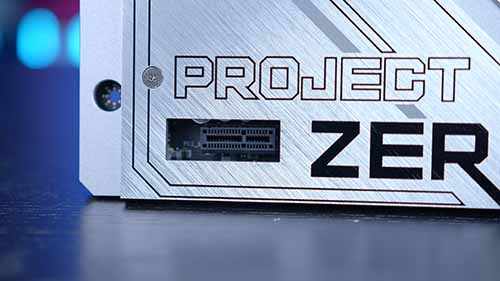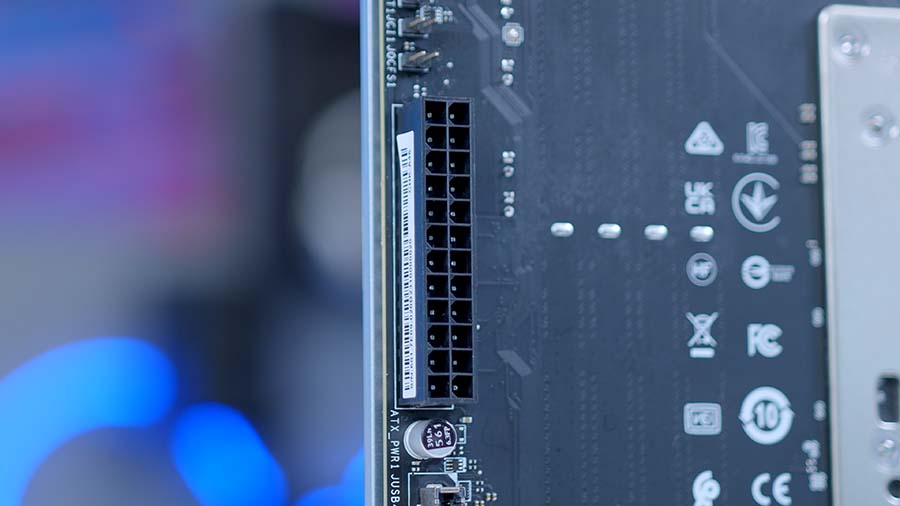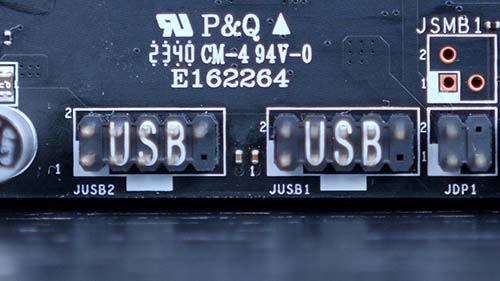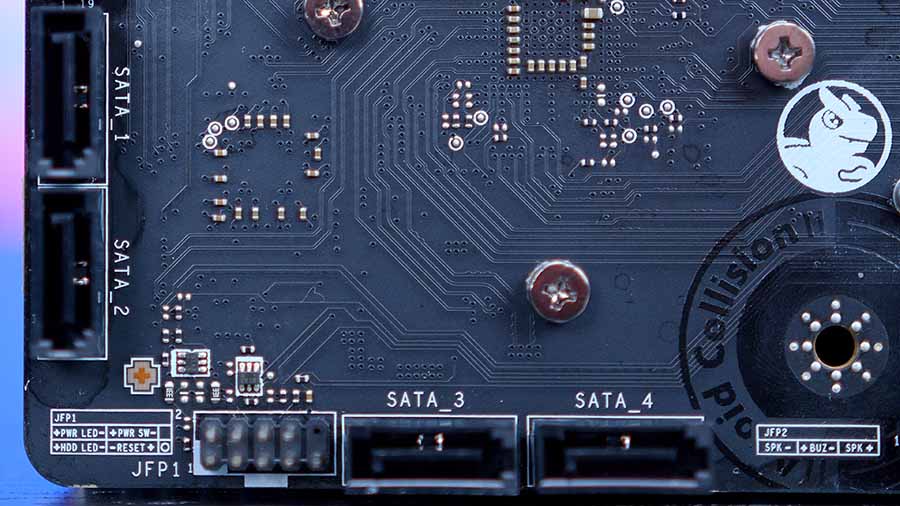The B650M PROJECT ZERO motherboard is MSI’s solution to cable management. PROJECT ZERO is part of a design standard, where all of the important motherboard headers such as CPU and motherboard power, USB connectors, and front panel power have moved to the rear of the PCB. The PROJECT ZERO branding sits alongside ASUS BTF and Gigabyte Project Stealth, which are alternative motherboard designs that also seek to target the bane that is cable hassle.
This unique design approach provides an alternative way to style a system, while also saving time during the PC building process allowing for cable management entirely at the rear of the case. The B650M PROJECT ZERO is a Micro-ATX reverse connectors motherboard that offers a strong set of rear IO, solid RAM overclocking headroom, and a sleek silver design that looks awesome in a lighter-themed system.
But does the MSI B650M PROJECT ZERO sufficiently improve the PC building process enough to be worth picking up versus a standard motherboard? In this review we’ll be taking a look at MSI’s B650M PROJECT ZERO motherboard, to assess if this new cable standardisation is a time-saver or a time waster. We’ve put the B650M PROJECT ZERO through a range of different tests to analyse the design, features, and versatility that this motherboard offers.
Buy the MSI B650M PROJECT ZERO on:
MSI B650M PROJECT ZERO Specs
From a glance at the specs, the MSI B650M PROJECT ZERO offers some great expansion and connectivity options. RAM can be overclocked to 7600MT/s, with all MSI boards also supporting capacities up to 256GB.
The B650M PROJECT ZERO comes with a singular PCI-E x16 slot, which supports Gen4 bandwidth, ideal for both NVIDIA RTX 4000 and AMD Radeon 7000 graphics cards. Both of the M.2 slots are also Gen4 supported too. It is a shame there isn’t any Gen5 expansion on this motherboard, but there are other PROJECT ZERO boards on the market that support this standard for graphics cards and SSDs.
| Specification | MSI B650M PROJECT ZERO |
|---|---|
| Form Factor | Micro-ATX |
| Supported Memory | 256GB DDR5 7600MT/s |
| PCI-E x16 Slots | 1 x PCI-E 4.0 |
| PCI-E x4 Slots | 2 x PCI-E 4.0 |
| VRM Power Phases | 10+2+1 |
| Front IO | 2 x USB 2.0 Headers 1 x USB 3.0 Header 1 x USB-C Header |
| Rear IO | 2 x USB 2.0 2 x USB 3.2 Gen1 3 x USB 3.2 Gen2 1 x USB 3.2 Gen2 Type-C 1 x USB 3.2 Gen2x2 Type-C |
| Audio | 1 x 3.5mm Mic In 1 x 3.5mm Line Out 1 x 3.5mm Line In |
| Networking | 2.5 Gigabit LAN WiFi 6E |
The MSI B650M PROJECT ZERO offers a VRM power phase design of 10+2+1, with 13 phases in total. Admittedly, this will limit CPU overclocking capability to a degree, but those with an overclocking capable CPU, will be able to push their processors by a few hundred megahertz with this board.
IO is the most standout area of the MSI B650M PROJECT ZERO, with both the front and the rear offering a bountiful set of ports to choose from. The front IO has 2 USB 2.0 headers, supporting up to 4 ports, 1 USB-C header, which supports a USB 3.2 Gen2 Type-C port, and finally, a singular USB 3.0 header, which can provide support for up to 2 USB 3.2 Gen1 Type-A ports.
The rear IO has 9 USB ports in total that can be utilised. The vast majority of the USB ports on the rear IO are made up of high speed options, along with 2 additional USB 2.0 ports. Realistically it would be nice to see these be replaced with a higher speed option, but they act as a set of backup ports for those that don’t need the stronger transfer speeds.
For a more detailed explanation of the specs, we’ve gone into further detail about the various headers and slots that this board offers below.
Suggested Article: Best B650 Motherboards to Buy in 2024
What is PROJECT ZERO?
PROJECT ZERO is MSI’s solution to simplifying cable management, moving all the headers on your motherboard to the back of the PCB. Gigabyte kicked off the ‘zero cabling’ trend with their Project Stealth PC which is a minimalist cabling PC build kit. ASUS have also provided a PROJECT ZERO competitor set to rival MSI’s boards known as ‘BTF’ or ‘Back To (the) Future’.
All of your power supply cables can easily be plugged into the various headers on the back, keeping all of the mess out of your vision. This provides a very clean PC build look once everything has been fully assembled.

The main caveat to note about PROJECT ZERO, is that these boards require a specific case that supports the rear cable design, as the header placement isn’t standardised across different brands.
While this does pose some restrictions in terms of case choice, we imagine manufacturers will shift to the standard over time as it becomes more popular. Overall, PROJECT ZERO looks to be an exciting prospect, and having now used it ourselves, we’re keen to see it saturate the market. We’ve also written a full review of MSI’s MAG PANO M100R PZ chassis, which is designed to house the new set of PROJECT ZERO motherboards.
What’s in the Box?
When buying a motherboard, the manufacturer often includes some extra items that can help ease the building process, or offer some quality of life improvements. The B650M PROJECT ZERO has a few additional items that are worth highlighting.
The first item in the box, is a quick installation guide. This small manual provides some brief instructions on where various cables should be plugged in. Alternatively, the QR code on the front can be scanned to get a full PDF.

The included WiFi antennae can be plugged into the rear IO in order to boost the signal of your wireless networking, providing better speeds over a longer distance.

For those with older storage drives, such as SATA SSDs or SATA hard drives, there are two included data cables within the box of the B650M PROJECT ZERO.

The included set of stickers also allow you to further personalise your PC build. You can label up some of the headers on your system, or put them on your PC case.

MSI B650M PROJECT ZERO Design
Upon opening the box of the MSI B650M PROJECT ZERO, you’re greeted with a rather sleek looking Micro-ATX motherboard, covered in silvery-grey heatsinks. MSI has opted for a more minimalist style, providing a brushed metal aesthetic that spans the entire board. You’ll find some PROJECT ZERO livery across two of the major heatsinks, these being the rear IO, and the cover for the M.2 slots.

I do like the overall look that this board presents. The black PCB contrasting with the steel heatsinks works quite nicely, providing a lighter theme that I’m a huge fan of. The fact that the heatsinks cover up the rugged and barebones aesthetic, is great too. The design of the B650M PROJECT ZERO is uniform and clean, which is the main goal that these boards seek to fulfil.

The B650M PROJECT ZERO doesn’t offer any built-in RGB, but the headers on this board offer some additional lighting options. This will allow you to plug in and configure any addressable RGB components by using MSI Mystic Light.

Connectivity Options
Graphics Card Slot
MSI’s B650M PROJECT ZERO board offers one graphics card slot. This is a Gen4 PCI-Express slot, so installing an RTX 4000 or Radeon 7000 graphics card is a viable option. Offering one graphics card slot is a common factor of Micro-ATX motherboards due to their smaller size, but this isn’t a large point of contention for us.

M.2 Slots
Underneath the large heatsink towards the bottom of the B650M PROJECT ZERO are 2 Gen4 M.2 heatsinks. These support 2280 and 2260 drives. It would be nice to see a Gen5 slot, opening up options for those looking to pick up faster storage.

RAM DIMMs
Because the B650M PROJECT ZERO sits on the AM5 platform, the RAM DIMM slots on this motherboard are DDR5 options. Supporting RAM can be clocked up to 7600MT/s on this motherboard, with the B650M PROJECT ZERO maxing out capacity at 256GB. While 256GB of RAM won’t be necessary for most, this opens up performance options for those building an enthusiast level system.

Rear IO
The rear IO of MSI’s B650M PROJECT ZERO is pretty solid, offering up a good range of options to choose from when it comes to ports. There are 9 USB ports in total, 2 of which are USB 2.0, and the rest are USB 3.2 Gen1 upwards. There are two Type-C ports on this motherboard, providing you with lightning-fast transfer speeds. The Type-C option labelled “SS 20” is a USB 3.2 Gen2x2 port that provides up to 20Gbps speeds, ideal for large file transfers or high speed peripherals.

In terms of networking, the B650M PROJECT ZERO offers a 2.5 Gigabit LAN port, or WiFi 6E. Both of these networking options are perfect for competitive gaming, but more stability is available through the wired ethernet connection. The smaller audio selection is a little bit basic, and will be more restrictive for those with complex setups, or the need for optical out.
On the troubleshooting front, you’ll find a Clear CMOS and Flash BIOS button towards the left side of the rear IO. Clearing the CMOS, or re-flashing the BIOS of a motherboard are quick solutions that can often fix some software related PC issues, so its great to see these as an inclusion on this board.
Internal Headers
CPU and Motherboard Headers
On the rear of the MSI B650M PROJECT ZERO is the CPU and motherboard power. This board offers a relatively standard power configuration when compared to alternative options.

You’ve got access to a 20+4 pin header for your motherboard, along with two 8-pin EPS CPU connectors, which are labelled ‘CPU_PWR1’ and ‘CPU_PWR2’. It is worth highlighting that both CPU headers don’t need to be plugged in, unless overclocking is on the cards.

Front USB Headers
In terms of front USB headers (these are the ports that will connect up to the PC case IO), there 8 USB ports to be leveraged. All of the headers are located on the underside of the board. Towards the bottom centre of the B650M PROJECT ZERO, there are 2 USB 2.0 headers, with both of them supporting a maximum of 2 ports.


On the left side of this board there is one header for USB 3.0 ports, which supports 2 USB 3.2 Gen1 Type-A options. Slightly above this is the USB-C header, which provides support for a singular USB 3.2 Gen2 Type-C port.
Front Panel Power (JFP1)
Front panel power (otherwise known as JFP1 which is its label), is located towards the bottom left of the PCB on the underside of the board. Plugging in the JFP1 headers can be quite finnicky, which is why we always recommend looking at the legend below the pins themselves. The main set of pins you’ll want to locate here will be labelled as ‘PWR SW’, which is for the power switch on your case. While some of the other JFP1 pins don’t need to be plugged in, we always recommend that novice builders get them plugged up regardless.

CPU, Pump and System Fans
Towards the top left of the B650M PROJECT ZERO, are the three main fan headers to power a CPU air cooler or liquid cooler. Towards the bottom of this board there are two additional system fan headers, providing some upgrading room for additional cooling support.


RGB Headers
The B650M PROJECT ZERO doesn’t have any RGB lighting built into the board itself, but for those with additional RGB components such as RGB lighting strips, these can be plugged into the ARGB headers. There are 2 headers located towards the bottom right of this motherboard, while the third is situated alongside the CPU fan header.


SATA Ports
In terms of SATA data connectivity, the B650M PROJECT ZERO has four ports in total. All of these are located towards the bottom left, on the underside of the PCB. This should be ample for buyers with older storage options such as SATA SSDs or hard drives.

Building with the B650M PROJECT ZERO
Building with the B650M PROJECT ZERO motherboard was quite finnicky to start with. Installing your CPU, RAM, and SSD isn’t really viable until the board is in the case, as you risk damaging the headers while the board is sitting on a work surface. This could pose some issues for first-time builders, as any misaligned headers could result in a broken power connector.
James noted that getting the B650M PROJECT ZERO installed in the case was a relieving feeling, as there was no worry of a potential slip or mishap with the board once it was screwed in. The rest of the components could then be installed like normal. The case that we used for this build was the MAG PANO M100R PZ, which supports the Micro-ATX PROJECT ZERO motherboards from MSI.

The power connectors that poke through the back of the case are very easily accessible. Being able to wire up your power supply without having to shift coolers around or pre-emptively wire up your system makes the building process much smoother.

The 24-pin motherboard power connector is also very easily accessible and can be managed using the included Velcro cable ties that come with the case.
Getting the front panel cables plugged in was relatively simple overall. JFP1 and HD Audio were very easy to spot thanks to the labels. The MAG PANO case also came with a dedicated header for JFP1, as opposed to the individual single pin connectors.
The USB-C connector did initially raise some concerns, as the header isn’t right-angled, which could potentially cause damage to the cable and header over time. However, MSI have since noted that the latest revisions of the MSI MAG PANO case will feature an angled header after initial feedback.

The lack of a hidden power cable for the graphics card does throw off the look a little bit, but newer PROJECT ZERO motherboards may offer a solution to this. Alternatively, a sleeved white cable would have helped this blend in a little bit more.
Our final build looked awesome. Although the B650M PROJECT ZERO is closer to silver than it is white, it blends in very well with the white case and other white components that we’ve used. Being able to wire up the case entirely from the rear was very useful, and made the overall building process much simpler.
Features We Like
Overclocking Support
In terms of VRMs, this motherboard sports a 10+2+1 power phase design, providing ample power delivery to the CPU. This will allow for a moderate CPU overclock, which can result in small performance uplifts in both games and tougher workloads.
XMP profiles can also be applied which will boost RAM speed up to 7600MT/s. Again, this will provide a small boost to performance in varying applications.

Back Connectivity Design
The reverse connectors design is a genius innovation. This alleviates the stress of cable management, because the vast majority of the headers on your motherboard aren’t visible. This means you won’t have to worry about making the cables presentable, saving a significant amount of time and effort.

Features We Don’t Like
Lack of Tool-Less Slots
Because this motherboard provides a much larger focus on being ‘DIY friendly’, we were expecting to see tool-less SSD or quick release GPU slots. However, MSI’s B650M PROJECT ZERO doesn’t have any. Tool-less latches and slots are a standard across most of MSI’s motherboards, so it is a shame to see that this hasn’t been integrated into this PROJECT ZERO design.

No Gen5 Support
Gen5 connectivity provides buyers with upgrade options for the future, whether you’re looking to improve your storage speeds, or you’re holding out for the next generation of graphics cards. Unfortunately, MSI’s B650M PROJECT ZERO doesn’t offer any Gen5 support, which means upgrading to a future generation of GPUs is slightly problematic.

Conclusion
MSI B650M PROJECT ZERO

Product Name: B650M PROJECT ZERO
Brand: MSI
-
Features
-
Design
-
Performance
-
Value For Money
Summary
MSI’s B650M PROJECT ZERO motherboard innovates and reshapes the way we build PCs by moving all of the cabling to the back of the PCB. By doing this, cable management becomes relatively hassle free, and the look of your PC build will be clean and sleek thanks to the lack of any cable mess. This motherboard also offers ample connectivity and expansion options, while providing a refined a premium design that looks excellent in a fully white system.
The only major drawbacks of this motherboard are the fact that you need a specific case to use it, and that there’s no hidden power solution for your graphics card. However, these are relatively small pay-offs considering the versatility that the B650M PROJECT ZERO offers. We’re very excited for the new wave of PROJECT ZERO motherboards, as these designs are changing the way we build PCs for the better.
Pros
✅ Internal headers placement
✅ Strong Rear IO
✅ Sleek design
Cons
❌ Requires a specific case
❌ No Gen5 support
❌ No hidden GPU power








